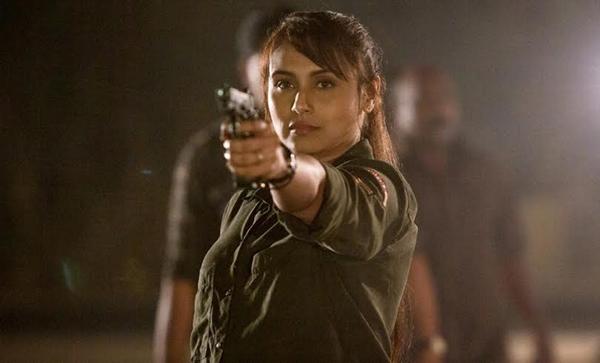 image
image
The avenging angels
Revenge is sweet, as many anti-heroes in Hindi films project. But though rather rare, heroines too take the same path to strike out against the oppressor, sometimes even going to the extent of killing. Shoma A. Chatterji takes a look at the larger picture
When women in some films kill to punish or to avenge, it might not always be to fulfill a personal agenda. Unlike women in real life who have little space or opportunity to avenge wrongs afflicted on them, cinema has given them the space to express themselves with action that transcends moral courage to translate to physical violence to overpower the enemy and destroy the evil force.
Mainstream Hindi cinema displays quite a few examples of simple, naïve women turning into raging avatars when wronged. When attempts through legal recourse fail to bring justice she invokes the ‘death sentence’ herself bypassing legal statutes..jpg)
In Mother India (1957), the moral force of the young nation is shown suffering but emerges triumphant in the end as a new ideal in Radha (Nargis) emerges. She shoots down her own son Birju, a dacoit, who terrorises her own village. This sustains the balance in society between dominance of traditional values on the one hand and suffering and anarchy on the other. From the personal status of mother, she makes motherhood a political statement when the agenda is a larger social purpose. Since there was already a price placed on Birju’s head, Radha does not go to trial for the killing and becomes the ‘mother’ or the matriarchal head of the entire village.
In Ketan Mehta’s Mirch Masala (1987) the women of a village who work in a red chilli factory use the only weapon, the red chilli powder, they have to avenge the killing of their watchman, an old Muslim. The watchman is shot down unprovoked by the villainous Subedar who demands that beautiful Sonbai, one of the workers in the factory, who staunchly refuses his advances, is handed over to him. The men surrender but the women do not and stand behind Sonbai stolidly. Mehta uses red chillies both as a metaphor and a physical reality which is a symbol of the three faces of woman power - economic productivity, filial responsibility, and destruction of the oppressing villain.
Prakash Jha's Mrityudand (1997) is an incisive political statement on the oppression of women in a Bihar village that has remained unchanged and patriarchy rules. The film shows that occasionally even a lone woman can trigger a rebellion against male oppression and humiliation. The heavily pregnant Ketaki (Madhuri Dixit) organises the women of the village to fight the ‘death sentence’ the two main villains have decided to apply on the two women – Ketaki and her sister-in-law Chandravati as the men feel threatened by the guts of these two women.
It is the heavily pregnant Ketaki who forces Tirupati, the evil contractor to seek refuge in the tank behind their home and shoots him down. The film attacks the very concept of male dominance in a man-woman relationship
Eighteen years later, the situation of women in real life is not very different, whether in the urban or rural milieu. The law-keepers try to skirt cleverly around issues like rape, dowry death or while attempts to soften some laws as IPC 498A alleging false cases and hence tilted against men. This is precisely why three recent films have been extremely popular with the audience, women forming a major chunk of them. They have brought woman power to the fore through physically aggressive and violent action. The films are Kahaani,Mardaani and NH10.
The woman’s(Vidya Balan) revenge in Kahaani is motivated by murder of her husband and her loss of fertility following the miscarriage when she learns about her husband’s death. Her revenge is well-planned and she succeeds.
.jpg) Mardaani has a larger agenda reflected through individual fights between one man and a woman in a tussle in who will win. But in the larger context, Shivani (Rani Mukherji), the police officer nails down the kingpin of child trafficking by having him killed by his own victims – the girls targeted for trafficking. The aggression and the violence at the end are lapped up, and not condemned by the audience because they are often helpless witness to a seemingly never-ending national problem and when someone like Shivani tackles it, it gives modicum of hope.
Mardaani has a larger agenda reflected through individual fights between one man and a woman in a tussle in who will win. But in the larger context, Shivani (Rani Mukherji), the police officer nails down the kingpin of child trafficking by having him killed by his own victims – the girls targeted for trafficking. The aggression and the violence at the end are lapped up, and not condemned by the audience because they are often helpless witness to a seemingly never-ending national problem and when someone like Shivani tackles it, it gives modicum of hope.
Meera in NH10 defines the sheer power of being a woman in anger, when a high-powered corporate executive is forced by circumstances to resort to violence in the background of the badlands of ‘khap’ culture – the only window of escape left for survival. Every time she seeks an escape route, it is filled with more villains than the ones that she left behind. She invents and improvises her own ways and exacts her revenge when she finds her husband killed by the villains. She never ever wanted to resort to violence but is forced to, and when she does strike back, how!
While women and girls in real life are trafficked, prostituted, molested, sexually harassed, raped, murdered for dowry and violated in hundred different ways as the law drags its feet, they can derive vicarious satisfaction from the Sonbais, the Ketakis, the Radhas, the Shivanis, the Miras and the Vidyas of the world, even if they are celluloid figures. They relate because their experiences are raw and real.
Top Headlines
-
Entertainment
Valentyn Vasyanovychs To The Victory! wins 2025 TIFF Platform Award unanimously
September 26, 2025
-
Entertainment
Chlo Zhaos Hamnet Wins TIFF 2025 Peoples Choice Award
September 20, 2025
-
Entertainment
Sholay: Golden even after fifty years
July 04, 2025
-
Entertainment
War 2: Check out Hrithik Roshan, Jr NTR and Kiara Advani's new posters
June 26, 2025
-
Entertainment
LGBTQIA+: Icelandic film Odd Fish and Brazil's Baby win big at KASHISH 2025 film festival
June 12, 2025
-
Entertainment
Katrina Kaif named Maldives tourism global brand ambassador ahead of Modi's visit
June 10, 2025
-
Entertainment
'Queen marches to conquer': Deepika Padukone joins Atlee's AA22xA6 starring Allu Arjun after 'Spirit' exit
June 08, 2025
-
Entertainment
Dakota Johnson and Chris Martin, who were in on-and-off relationship, broke up: Reports
June 06, 2025
-
Entertainment
Sharmila Tagore to Alia Bhatt, India weaves cross-generational tale at Cannes 2025
May 28, 2025
-
Entertainment
Is Sandeep Reddy Vanga's cryptic 'feminism' post meant for Deepika Padukone? Neitzens think so
May 27, 2025


